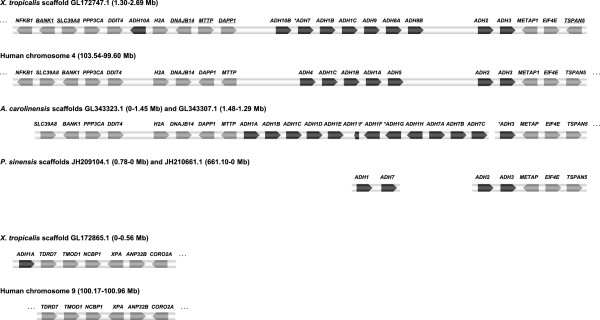Figure 3.

Chromosomal location and synteny of ADH loci.X. tropicalis scaffolds GL172747.1 and GL172865.1 are compared to human syntenic chromosomes 4 and 9, A. carolinensis scaffolds GL343323.1 and GL343307.1, and P. sinensis JH210661.1 and JH209104.1. All the identified genes are shown transcriptionally oriented (ADH genes in black and others in grey). The genes marked with an asterisk lack the first exon in the assembly. The opposite orientation of several orthologous genes (underlined) in X. tropicalis and human suggests a past inversion and posterior rearrangements involving the ADH cluster. In contrast, frog genes between NPNT (nephronectin, not shown) and NFKB1, located at 0.58-1.30 Mb of scaffold GL172747.1, have the same orientation as their human orthologues (not shown). Gene symbols in human chromosomes are NFKB1: Nuclear factor of kappa light polypeptide gene enhancer in B cells 1, SLC39A8: Solute carrier family 39 (zinc transporter) member 8, BANK1: B-cell scaffold protein with ankyrin repeats 1, PPP3CA: Serine/threonine phosphatase 2B catalytic subunit (alpha isoform), DDIT4L: DNA-damage inducible transcript 4-like, H2AFZ: Histone H2A family member Z, DNAJB14: DnaJ homolog subfamily B member 14, MTTP: Microsomal triglyceride transfer protein, DAPP1: Dual adaptor for phosphotyrosine and 3′-phosphoinositides, METAP1: Methionine aminopeptidase 1, EIF4E: Eukaryotic translation initiation factor 4E, TSPAN5: Tetraspanin 5, TDRD7: Tudor domain containing protein 7, TMOD1: Tropomodulin-1, NCBP1: 80 kDa nuclear cap binding protein, XPA: DNA-repair protein complementing XP-A cells, ANP32B: Acidic leucine-rich nuclear phosphoprotein 32 family member B, CORO2A: Coronin-2A.
